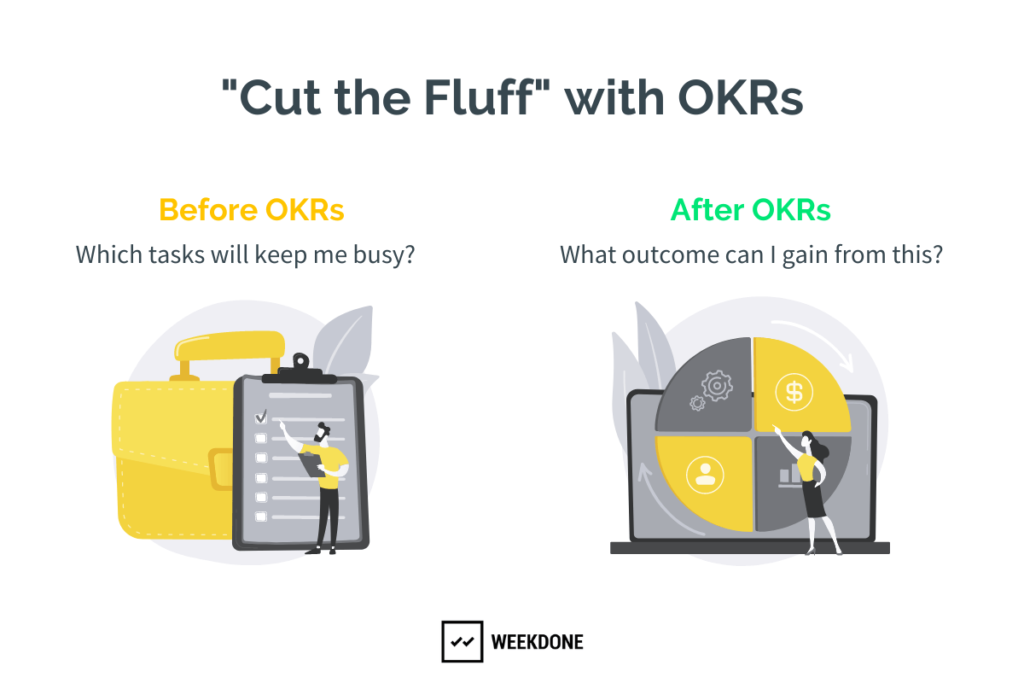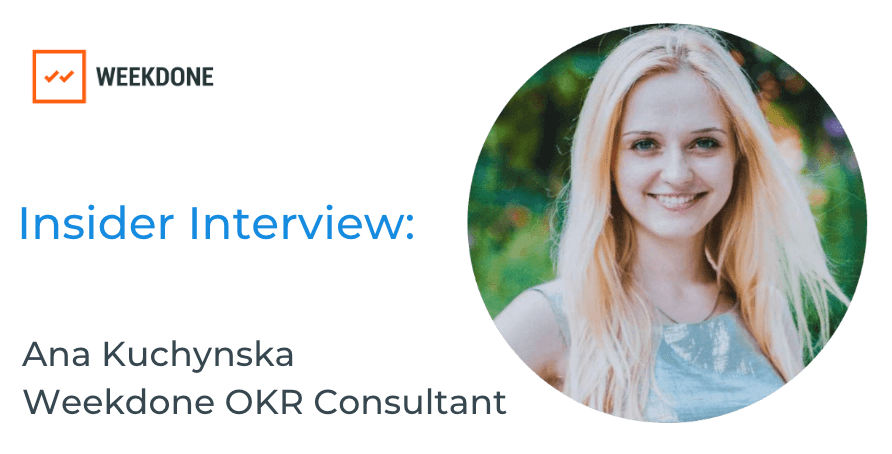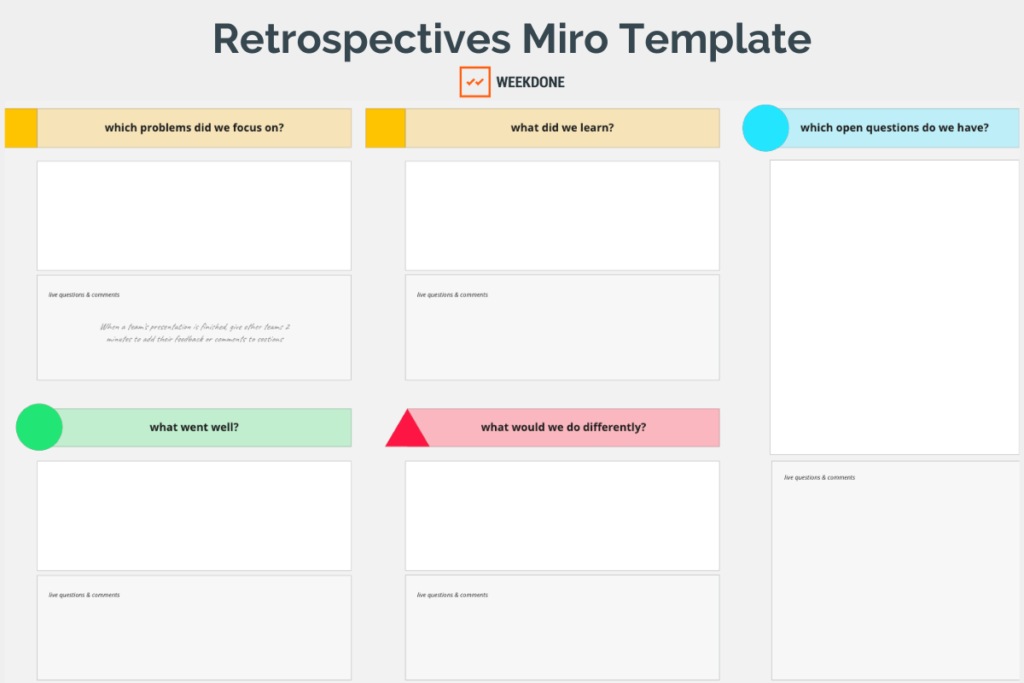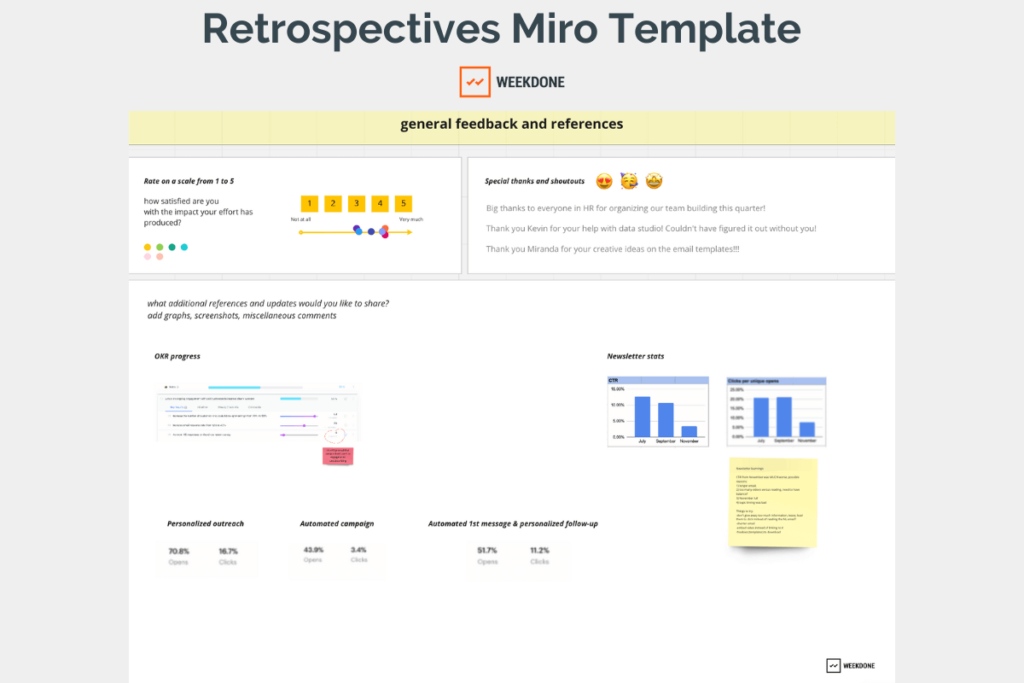As we get closer to the start of a new quarter, it’s time to do some critical thinking on all the work that has been implemented during the last 3 months. More specifically, dissect the impact of these actions and overall progress made on the company’s bottom line.
Whether you’re new to the OKR methodology and want to understand how the retrospective fits into the OKR process – or you’re already using OKR software and want insight into running a company-wide retrospective meeting, we’ve got something in here for everyone!
So, let’s get right to the interview! Enjoy these nuggets of wisdom from Weekdone OKR coach, Ana.
What is a retrospective?
A retrospective is also called a review or summary. With OKRs, the best practice is to work with a quarterly review (retrospective). But in general, a retrospective is a process for zooming out on your day to day work and looking at a bigger picture – whether on a daily, monthly, quarterly or annual basis.
Sometimes you need to take a step back to see if what you have been doing is working, is not working, or what you need to change. The purpose of any retrospective regardless of how you facilitate it (a meeting, chat, or whatever) is to answer 2 questions:
1. What will we do differently
2. Which open questions do we still have?
It’s important to hold a retrospective meeting – because these answers will help you to write better goals for the next quarter – regardless of whether you use OKRs or not. It will give you the opportunity to understand what are the few things we need to focus on for a designated time period.
What is the major purpose of holding a company-wide retrospective?
A retro is always a part of a larger planning discussion. First you hold a retrospective meeting, then you plan for the next quarter. Retrospectives allow for:
- Continuous alignment
- Staying focused
- Figuring out dependencies between teams
Assuming that a company or team wants to write better goals – you must first give people an opportunity to put all their cards on the table. And that’s what a retrospective gives you!
Any meeting is about connecting dots. Sometimes more often than not, you have no idea which dots need to be connected. It’s not until you see everything together can you make the connections between seemingly unrelated subjects – or have a breakthrough!
It’s impossible to have a breakthrough if you don’t have all of the moving pieces in front of you.
That’s why I like our Retrospectives Miro template so much, because it’s literally “putting the cards on the table”
First your really need to think through –
- What problems did we focus on?
- What did we learn?
- What went well?
Only by answering those questions can you narrow down:
1. What will we do differently
2. Which open questions do we still have?
When you do a retrospective – you start evaluating more realistically what each of your projects mean in terms of effort. I think it’s especially important for motivation. Because if you forget how much you’ve done then you don’t appreciate your value! This process allows you to access this over and over again – and other people will see it as well.
Would you say a retrospective is most important on the company level?
In traditional business – it’s usually understood that the leaders and top management should be doing these retrospectives. However, it’s much more useful to use that time to invite everybody to share their insights and to give input. Allow them to list what they think is working, and share what kind of questions everyone has. The retrospective is a process, as with everything in business. And it has several stages.
The stages of a retrospective process:
Stage 1: Individual retrospective
Everyone needs to do this retrospective process individually and answer the questions on their own about their team. These replies are then sent to the team manager – who is the alignment point for everyone. Team managers look at the responses and try to consolidate the data to find some common patterns (as to remove the repetition) and create some sort of “team summary”.
Stage 2: Team retrospective
This is for discussing everyone’s insights. As you may run into single noted issues – or have different angles related to the same problem. The agenda here is based on whatever came from individual exercises (step 1). There may be even several discussions on this topic so everyone has time to speak up. These should not have a time limit. You may schedule an hour per day – to keep engagement levels high. But you can schedule a retrospective week, whatever time you need until you’re absolutely sure you’re done, and then you’re done!
From here, team managers again take all this gathered information and bring it to the 3rd stage.
Stage 3: Company-wide retrospective
This needs to be time regulated for sure. Each team manager takes 3-5 minutes to present their summary as well as 3-5 minutes for others to ask questions from that team. It’s very important to have a facilitator, ensuring that questions are being asked, and time is moving on as planned. It’s important that everyone comes to these meetings prepared. There is nothing worse than having to endure something that someone hasn’t prepared for – as you risk others not wanting to come to this meeting again.
What would you expect to happen if a company skipped their retrospective and went directly into the next quarter?
It’s going to be really painful to write goals. If you’re working with OKRs it will be hard to write OKRs, if you’re just coming up with a few things to work on it’s going to be painful to understand what is the most important thing. Because you didn’t do your preparation.
If you don’t do retro, there is no way to make informed decisions on how to move forward. I think it is more dangerous if the team doesn’t do the retrospective.
Let’s especially consider growth or marketing teams. You have this list of 100 things you could be doing (i.e. organize an event, start working on partnerships, run some paid ads, create videos). And if you don’t do retro, there is no way to make informed decisions on how to move forward, or which one to start with. You feel like the weight of the world is on your shoulders. So you procrastinate – and it’s normal! Humans procrastinate when there is too much in front of them.
Company-wide retrospectives cannot function well without the team level. So it has to be the 3 stage process.
If it’s too much at first, you can stop at the team level retrospective – especially if there are no dependencies on other teams. But this rarely happens. The whole point of introducing some formal goal-setting in a company is to get departments and teams to talk to each other.
Company success is always a combination of different teams. No one team can claim success in a company. All problems are complex, so you need to approach them from different angles. And if you don’t have all the stakeholders presenting their learnings – you’re not going to have a chance of noticing opportunities that could have been staring you in the face!
This is a stepping stone toward better teamwork and internal communication. It’s a process of communicating more effectively.
So, what makes a retrospective successful?
A successful retrospective has done the following:
- It makes everyone feel heard and that they have been given a chance to contribute.
- It needs to end with actionable items. What will you do with this information? It’s not only for ideation – but what topics do you schedule a follow-up for?
- On the company level, there needs to be cross-team collaboration.
The 3rd point is the hardest and it often falls under the role of the facilitator to make sure comments are made and questions are asked. For example, once one team has finished their presentation – others need to write down their questions and have the team answer it (either immediately, or later on).
If you don’t force this process – the rest of the teams will do their own thing while others are presenting! It doesn’t have to be stressful! You can introduce a 5-minute break between team presentations where music plays and comments and questions are written down by other teams. Structure this time however it works for your company.
And my obvious next question is – what makes it unsuccessful?
This is different for teams and company-wide retrospective. For team level retrospectives, it would be unsuccessful if you didn’t spend enough time. And for company-level it’s the opposite – you didn’t regulate your time.
Other obvious things are: how useful is the information being shared by teams? We’re not doing this for the sake of doing it. We want to start meaningful conversations.
What are the greatest benefits of running a retro with OKRs?
The OKR process offers formal structure for teams and companies. It’s a very straightforward process everyone can follow. It’s scalable – so it works as you add more people and employees.
What makes retrospectives better with OKRs is that you have a very specific framework to discuss what matters. Otherwise every conversation is about everything and nothing at the same time! It can go many directions – if people have no structure it’s usually disorganized and meaningless, unfortunately.
Retros are really important for the OKR process to succeed. And the other way also works – your retrospectives are going to be more: insightful, better, and structured if you’re doing them with OKRs.
With OKRs you had a specific goal in mind and specific outcomes you wanted to achieve. Combine this with your retrospective and now you’re discussing if those were the right things to drive. It’s the quality of your answers that change.
Getting people to ask the question, “what are we doing this for?” This is what OKRs do for businesses. You get every individual assessing each of their daily tasks, asking “why am I doing this?”.
You’re getting people to think of an actual outcome they want to achieve. Versus just doing things to keep busy. And this is a huge change in thinking. This is what it means to “cut the fluff”.

What’s the difference between a Weekly OKR Check-In and a team retrospective?
OKR process consists of various types of interactions:
Once the team finalized the OKRs and is ready for execution, there are several types of ongoing reviews they need to manage:
- OKR Weekly Check-Ins
- Monthly team retrospectives
- Quarterly company-wide retrospectives.
These are the processes that OKRs includes – this is what “working with OKRs” means.
When we say that every week, or every two weeks we have OKR check-ins – those are not big picture retrospectives. Those are smaller scale analysis that is supposed to facilitate better execution! Meaning, you do something and then review effort/impact balance to see if you are working on the right things. If it didn’t work, you prioritize something else, and if it did work then you continue with it. But you’re always doing it toward the same outcomes that you defined at the beginning of the quarter.
You create your Team Objectives and Key Results, then you do weekly check-ins to come up with ideas to drive forward and keep focus on those OKRs. When the time comes to hold a retrospective, you take a step back and think – what did this OKR mean for the company, and what did it mean for our team?
It’s very important that in company-wide retros we are asking if the company is on the right track. Is our team OKR aligned with the company Objective? What is missing – what do we not have? Could we do something differently? Very often leaders who are uncomfortable with these answers want to skip it – because they’re scared of what is going to be brought up.
But this is something that our customers say a lot after a few quarters with OKRs – “to achieve anything you need to be brave because there will be things you don’t want to hear”.
What advice would you give to companies new to OKRs and starting retrospectives?
I would say “start early” – give it a month. Don’t try to rush it. With the retrospective itself as a part of a planning process – take it week by week. From here, writing your OKRs will be much simpler.
Week 1 – allow people to do their individual gathering of insights.
Week 2 – have team managers gather those insights and talk to employees individually as needed.
Week 3 – have the teams facilitate their retrospectives.
Week 4 – have the company-wide session where team managers are presenting their team-level findings. And maybe have a follow up week to ask questions and have a company level discussion.
After this – write and set your OKRs and explain the expectations.
So don’t rush it. Next time it will take 1-2 weeks depending on your certainty level.
For experienced companies – do you have any tips for keeping the energy alive after the retro?
The tips would be all about writing good OKRs and finding the right things to measure. For the simple reason that if your OKR is written properly and you’re engaging with it during the quarter, naturally teams will want to share their learnings during the retrospective.
So, it’s not about keeping the retrospective interesting – it’s about making the working with OKR process interesting. It comes full circle!
Thank you Ana!
Ana shared so many awesome insider tips with us in this interview – we hope you learned something new and are ready to begin your retrospective process courageously with a clear plan!
For more insightful information and tips from our OKR experts – watch our webinar recording to learn more about How to Measure your OKRs Successfully.


